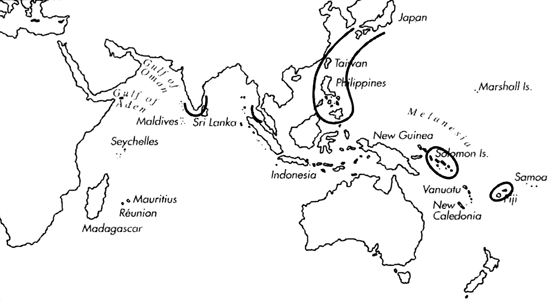
Skip Navigation Links
View access keys for this site.

Range: C. a. australis: Japan to Philippines and Vietnam; India and W. Thailand, probably also Fiji; C. a. gabryae: Solomon Is.
Description: C. a. australis (Pl. 46, Figs. 1-8) moderately large to large, moderately solid to solid. Last whorl narrowly conoid-cylindrical to ventricosely conical, to conical in subadults; outline variably convex adapically, less so to straight below. Shoulder subangulate to sometimes angulate. Spire of moderate height, outline slightly concave to slightly sigmoid. Larval shell of about 3.25 whorls, maximum diameter 0.8-0.9 mm. First 2-7 postnuclear whorls tuberculate. Teleoconch sutural ramps flat to slightly concave, with 0 increasing to 3-8 spiral grooves. Last whorl usually encircled with variably spaced, variably granulose ribs sometimes grouped in pairs or replaced by ribbons; intervening grooves narrow to wide and axially striate. C. a. gabryae (Pl. 46, Figs. 9-11) smaller. Last whorl ventricosely conical to ovate, also narrowly conoid-cylindrical in subadults. Shoulder angulate. First 3-5 postnuclear whorls tuberculate. Teleoconch sutural ramps flat to concave, with 1 increasing to 3-4 spiral grooves. Last whorl with granulose ribbons or pairs of granulose ribs from base to shoulder; shells with strongly granulose prominent spiral elevations intergrade with shells with a preponderance of axially striate incisions. Otherwise, C. a. gabryae matching C. a. australis in shell morphology.
| Shell Morphometry | ||
|---|---|---|
| L | - | |
| RW | - | |
| RD | - | |
| PMD | - | |
| RSH | - | |
C. a. australis: Ground colour white, often suffused with pale yellow or brown. Last whorl with brown spirally or axially aligned dots or flecks, axial streaks, flames and dashes. Pattern elements merging into 3 interrupted to solid brown spiral bands, below shoulder and above and belowcentre. Larval whorls white. First 1.5-3 postnuclear sutural ramps immaculate. Following sutural ramps with brown radial blotches and streaks. Aperture white, sometimes violet deep within. C. a. gabryae: Colourpattern as in C. a. australis, except last whorl often with elongate axial lines, mostly brown. Aperture white.
Periostracum brownish olive, thin, slightly translucent, smooth. Periostracum dark brown.
Radular teeth with an adapical barb opposite a blade; serration twice as long as blade, ending in a cusp at centre of shaft; central waist and basal spur present (Rolán, pers. comm., 1993).
Habitat and Habits: C a. australis in 35-240 m. Original material of C. cebuganus was dredged in "sandy-mud bottom" in depths of 20-40 fathoms." C. a. gabryae in 120-180 m.
Discussion: For comparison with C. laterculatus, C. kuroharai, C. armadillo, C. leobrera, and C. ranonganus see the Discussions of those species. We provisionally recognize C. a. gabryae as a subspecies restricted to the Solomon Is. It differs from C. a. australis mainly in having a more ventricose to ovate last whorl, and some specimens have colour patterns not known in C. a. australis. In 1989, L. Raybaudi Massilia described the subspecies C. a. gabryae under the name "Conus (Asprella) armadillo gabryae". However, this name is not available under ICZN Art. 7A, and redescription was required (Korn & Röckel, 1992). C. alabasteroides (Pl. 46, Fig. 7) and C. cebuganus (Pl. 46, Fig. 8) are based on subadult specimens of C. a. australis and are synonyms. C. duplicatus matches deep subtidal shells from the Philippines (Pl. 46, Fig. 5) in shape and sculpture (Röckel, 1987b). We therefore consider it an ecological form of C. a. australis, characterized by strong, paired ribs on the last whorl, weak spiral colour bands, predominant short axial lines and dashes, and a rather straight last whorl outline.

C. australis range map
This section contains verbatim reproductions of the accounts of 316 species of Conus from the Indo-Pacific region, from Manual of the Living Conidae, by Röckel, Korn and Kohn (1995). They are reproduced with the kind permission of the present publisher, Conchbooks.
All plates and figures referred to in the text are also in Röckel, Korn & Kohn, 1995. Manual of the Living Conidae Vol. 1: Indo-Pacific Region.
The range maps have been modified so that each species account has it own map, rather than one map that showed the ranges of several species in the original work. This was necessary because each species account is on a separate page on the website and not confined to the order of accounts in the book.
Return to framed version (returns to search page)